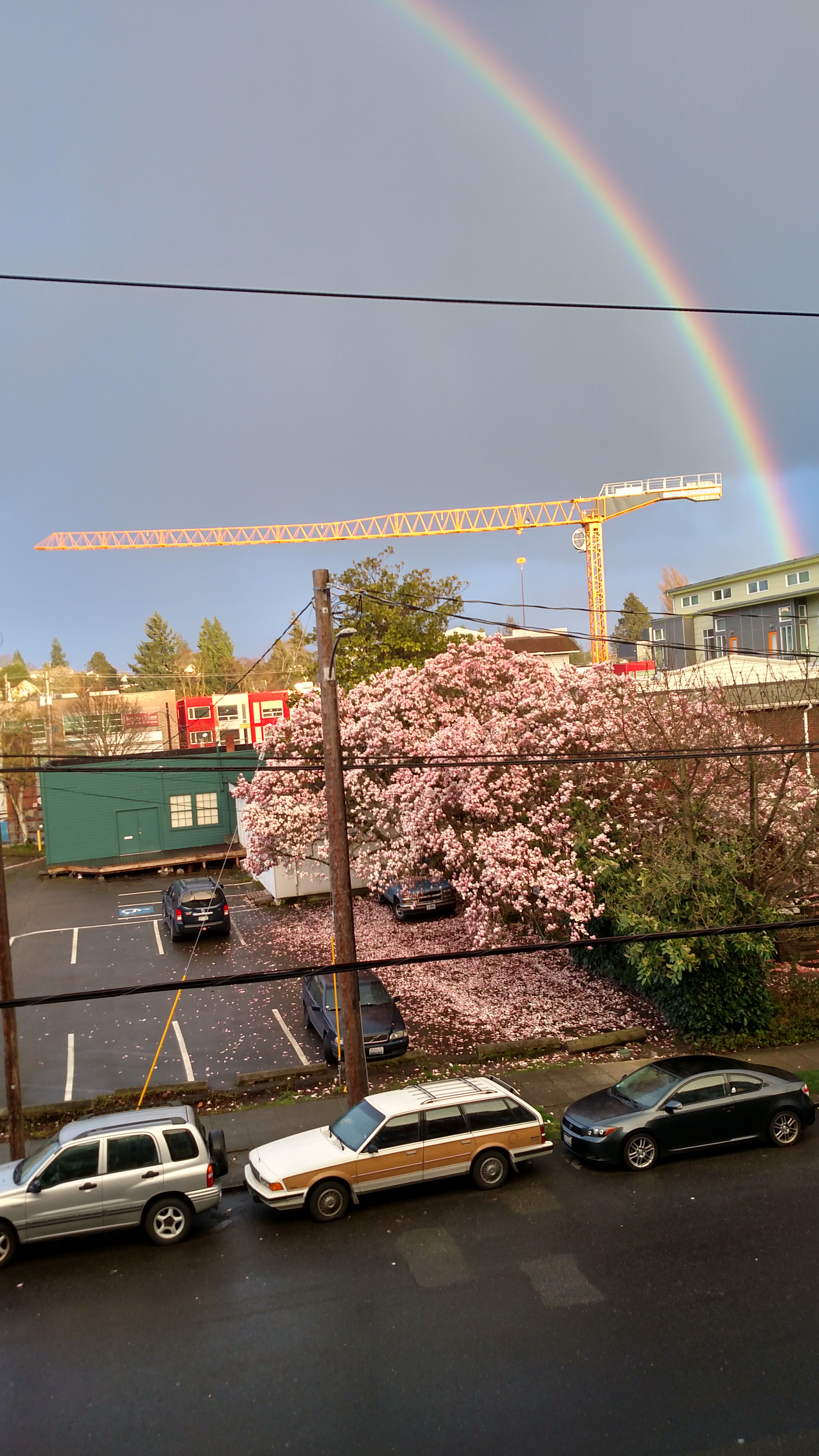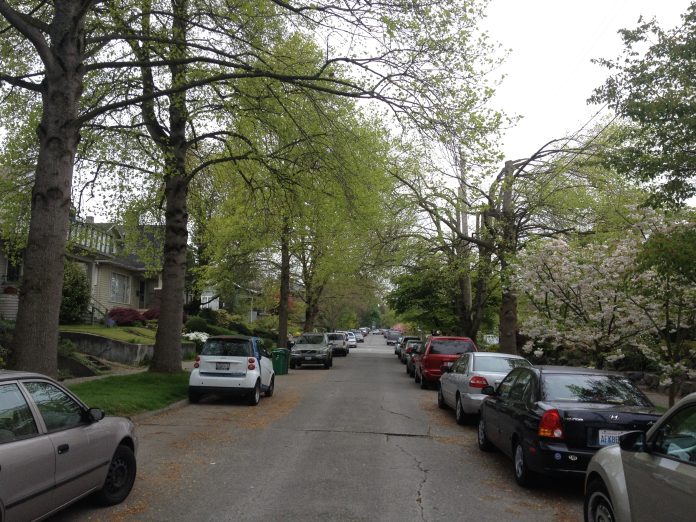Seattle hopes to tackle the loss of tree canopy through new regulations, which is gradually falling according to recent data. In late August, a draft ordinance was released that takes a wide-ranging approach to protect and beef up the leafy canopy blanketing the city.
At a minimum, non-development removal of significant trees would require a permit from the city with choices for replacement, adherence to minimum tree canopy requirements, or fee payment that would fund off-site replacement. Right now no permit is required in such cases in most zones, except that the number of significant trees allowed for removal in a given year is capped at three. But in practice, this maximum is often violated by property owners. The legislation would also add a new, broad definition of “significant tree,” establish hefty fines for tree removal without permission (up to $45,000 per trees in some cases), and impose new minimum tree canopy requirements.
To streamline the tree protection and tree canopy regulations, the legislation would consolidate nearly all of the provisions to Chapter 25.11 of the Seattle Municipal Code (SMC). Several related provisions are smattered in other chapters and sections of the code. In doing this, existing regulations under Chapter 25.11 SMC would be repealed and replaced with the new regulations and policy direction that the city council would be setting.
Yesterday, the city council held a public hearing on the yet-to-be-introduced ordinance at the Planning, Land Use, and Zoning Committee. Feedback from the public was generally strong with most demanding that the city council seriously address tree canopy loss. How to get there, however, was a matter of debate with some wanting more tree installations in streets, higher tree canopy requirements for urban districts, and different approaches from the ones being offered in the draft legislation.

Proposed tree removal permit framework
Generally, most tree removal activities of significant trees would require an approval before the action could be carried out by a property owner. Even emergency tree removals would at least need to involve contact with the Seattle Department of Construction and Inspections (SDCI) within one business after the emergency removal was performed and submission of a tree removal permit application within one week of such removal. The overall framework for tree preservation and tree canopy laws would be noticeably different in several ways:
- Tree removal permit types. Tree removal permits would come in two flavors: a minor tree removal permit and a major tree removal permit. The difference between the two types boils down to how many significant trees would be removed and whether or not the activity is associated with a development proposal. Property owners wanting to remove trees from a site would need to submit a tree removal permit application or other development application before tree removal could be authorized.
- Significant tree definition. A new definition for “significant tree” would be added to the Tree Protection Code as any tree six inches or greater in diameter at standard height. However, the legislation omits current law for “exceptional trees,” which may be individual trees or groupings of trees (groves) with “unique historical, ecological, or aesthetic value.” SDCI currently has standards for designating such trees. During the meeting, many people lamented the absence of these trees in the draft legislation and councilmembers urged Council Central Staff to develop changes that incorporate incentives for their preservation in addition to significant trees.
- New minimum tree canopy requirements. Proposals to remove trees would be based on compliance with maintaining a minimum amount tree canopy on the site or lot, as noted in the following table. The minimum tree canopy requirements differ based upon zone with the lowest density zones having the highest requirements. Single-family areas, for instance, would need to achieve 33% tree canopy coverage on a lot. These areas are experiencing the highest rates of tree canopy loss in the city, according to recent data.

- Calculating tree canopy coverage. Calculation of tree canopy coverage is the entire area of the site (at minimum a full lot) plus any right-of-way land fronting the lot time the minimum percentage required. This gives the total square footage of tree canopy required. To assess how much an individual tree provides in coverage, the following table is used. Each individual tree would be added together even if there is overlap in tree canopy coverage. Generally, if there is a deficit in required tree canopy coverage, then the applicant would need to replace trees such that the replacement trees would achieve the required minimum tree canopy coverage within 25 years.

- Minor tree removal permit. A minor tree removal permit would only be approved if the applicant can demonstrate that removal of one or more significant trees would not bring the lot below the minimum tree canopy requirement, can demonstrate that the tree meets the hazardous tree risk assessment (discussed below), or can demonstrate that the lot is already below the minimum tree canopy requirement and proposes a tree replacement plan to attain compliance. If the latter option is chosen, an applicant would have several choices to attain compliance through on-site and off-site plantings or fee-in-lieu payment to the city for tree canopy management. Off-site plantings would need to occur within the city and receive written consent from the property in question, whether private or public.
- Major tree removal permit. A major tree removal permit would be required anytime a development proposal would remove significant trees such that the site would fall below the minimum tree canopy coverage requirements. In single-family residential zones, the developer would have to propose a replacement plan that meets the minimum tree canopy coverage requirements through on-site plantings only. All other zones could meet their replacement plan obligations for tree canopy coverage through on-site and off-site plantings or a fee-in-lieu payment to the city. However, tree removal approval would be contingent on the applicant demonstrating a site planning need to remove the trees. The legislation outlines specific strategies that should be employed through the site planning process to avoid removal of significant trees where feasible.
- Tree protection practices, off-site tree replacement standards, and continued maintenance. For trees that are to be retained during site construction and tree removal, the legislation spells out specific practices to protect remaining trees such as directional felling, protecting drip lines, establishing protecting barriers around retained trees, and avoiding disturbance of retained trees. Off-site tree replacement would come with various standards including size and allowed tree type. The off-site replacement trees may be on public or private land when authorized by the relevant property owner and the owner agrees to commit to ongoing maintenance and health of the trees.
- Hazardous tree risk assessment. A new standard would be established to determine whether or not a tree constitutes a hazard. For non-hazardous trees (defined as anything other than “high risk”), the city arborist may recommend pruning instead of removal of the tree unless pruning would not adequately mitigate hazard risk.

- Tree removal permit fees. When a tree removal permit is required, the applicant may need to pay an application fee. The draft legislation identifies different fee categories for minor and major tree removal permits but no specific amount has been set on the permit fee costs. However, Council Central Staff noted in a report that tree removal associated with a development proposal should involve a substantially higher fee due to the complexity of review. Staff at the hearing also said that collaboration with SDCI was underway to better understand administrative and processing costs. Additionally, fee-in-lieu payments may be made in some cases if an applicant elects to not replace trees on-site or off-site. Fee-in-lieu payments would go to the SDCI Tree Replacement Fund, which would be used for tree planting throughout the city. The required payment would be based upon the size of the removed tree at a standard rate to be set by SDCI rule.
- Land Use Code incentives. To further encourage preservation of existing tree canopy, particularly in higher density zones, several incentives would be provided through development standard departures from the Land Use Code. These include extra building height, reduce setbacks, and reduced parking requirements in certain cases.
- Enforcement. If replacement trees are not cared for, the property would be responsible for replacing them if they die. The legislation would adopt very stringent enforcement requirements to compel property owners to comply with the tree preservation and tree canopy laws, including high civil penalties. Violations of stop work orders could involve penalties of $500 per day. Civil penalties of $1,500 per inch of diameter at standard height of tree removed or topped, up to $45,000 per tree, would also be possible. Malicious violations of the laws could allow the city to triple the fines. And for the worst offenses, a criminal penalty of $1,000 and up to 90 day of imprisonment would be possible charges for first time offenses. Multiple violations could garner more jail time and fines.
The legislation is poised to return to the Planning, Land Use, and Zoning Committee on September 19th for further discussion. At that time, Council Central Staff should have a more refined proposal addressing the issues that councilmembers raised during this week’s meeting. This includes things like retaining a limit on three significant trees per year, enforcement provisions, and alternative tree replacement calculation methodology based on ecological value. Several other issues raised by the Seattle Urban Forestry Commission like ability to pay, preserving groves of trees and exceptional trees, and noticing requirements may also find their way into the proposal. No action is planned for the next meeting as it will essentially be a working meeting on the evolving proposal.
Tree Regulation Updates Draft Ordinance by The Urbanist on Scribd
Seattle Considers Greater Tree Planting and Preservation Measures
Stephen is a professional urban planner in Puget Sound with a passion for sustainable, livable, and diverse cities. He is especially interested in how policies, regulations, and programs can promote positive outcomes for communities. With stints in great cities like Bellingham and Cork, Stephen currently lives in Seattle. He primarily covers land use and transportation issues and has been with The Urbanist since 2014.


